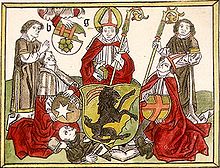Konrad Bitz

Konrad Bitz (also Kort Bitz ; † March 13, 1489 in Kustö ) was bishop of Turku in Finland from 1460 until his death .
Life
Konrad Bitz was the son of Henrik Bitz and Anna Klausdotter Diekn. Its first documentary mention can be found in sources from 1433, more precisely: on the occasion of his studies at the University of Leipzig , founded in 1409 , the second oldest university that has been working continuously since its foundation (after the Ruprecht-Karls-Universität Heidelberg , 1386) in the field of Federal Republic of Germany . After successfully completing his master's degree, ten years later he began studying canon law at the University of Bologna , the first university on European soil. With this training and his aristocratic status as a basis, it was possible for him to enter the career for higher church offices. After Olaus Magnus was appointed Bishop of Turku in 1450, Bitz succeeded him in his previous office as Provost and, after his death in February 1460, inherited him as bishop a good six months later on July 4th. It was followed by a visit from Bitz at the Roman Curia, which is also mentioned in a document, and then in Siena the consecration as bishop .
effect
Bishop Bitz commissioned the missal Missale Aboense, printed in 1488 by Bartholomäus Ghotan in Lübeck . The name of the book refers to the Swedish name of the city, Åbo. The work is the only incunable in Finland. This first book ever printed for Finland is considered a national shrine there. As a missal, it takes up Finnish peculiarities, such as the legend about Heinrich von Uppsala . Of the work reproduced in Lübeck in 1488, around 120 copies were produced cumulatively for both variants on paper and parchment. The missal comprises 226 sheets in folio format and although it is basically a liturgical work in Latin, it contains a foreword by Bitz and a calendar of the diocese in Finnish. In the middle of the picture on the cover is Bishop Henrik , who after his martyrdom was named the patron saint of the Church of Turku and all of Finland, and at his feet the farmer who is said to have killed him. In addition, Bishop Konrad Bitz was immortalized in the picture on the right and the then cathedral provost Maunu Niilonpoika Särkilahti († 1500, bishop), who was to follow Bitz later as Bishop of Turku, on the left.
In addition, Bitz ensured a leap in development at the level of art. Specifically: While the medieval churches in Finland showed an outwardly "austere and strict economy of decoration and structure", at the beginning of the 15th century they were with lime paintings in the al-secco technique, that is, watercolors on a dry lime ground adorned with an "unusual rich, sparkling painting". In addition to Bitz, who was responsible for a “fantastic animation of the interior, which still seems to be fed by Nordic animal ornamentation”, the art-loving Bishop Magnus Olofson Tavast (1408-50) and the Dominican Order, who maintained monasteries in Turku and Wiipuri, were in charge 'At Bitz's instigation', for example, Petrus Henriksson came from Sweden in 1470 to paint the church in Kalanti.
Outside his sphere of influence lay the loss of valuable documents when, during his pontificate in 1485, the Turku bishop's castle Kuusisto burned down and with it a large part of the church archives.
Web links
- Entry on Conrad Bitz on catholic-hierarchy.org ; accessed on May 13, 2016.
Individual evidence
- ↑ Seppo Suvanto: BITZ, Konrad. In: Biografiskt lexikon för Finland. 1. Svenska tiden. March 13, 2014, accessed November 15, 2017 (Swedish).
- ↑ Kirsi Salonen: Benefici, Omicidi, Pellegrinaggi . In: Brigitte Flug, Michael Matheus, Andreas Rehberg (Hrsg.): Kurie und Region. Festschrift for Brigide Schwarz on her 65th birthday . Franz Steiner Verlag, 2005, ISBN 978-3-515-08467-3 , pp. 439 ff . ( limited preview in Google Book search).
- ↑ Esko Häkli, Friedhilde Krause (ed.): Bibliophile and book history in Finland . On the occasion of the 500th anniversary of the Missale Aboense. German State Library Berlin and Helsinki Library, Berlin 1988, ISBN 3-7361-0035-3 .
- ^ The Missale Aboense (1488) in the Jyväskylä UB. In: jyk.jyu.fi. Retrieved November 15, 2017 .
- ↑ Jürg Glauser (Ed.): Scandinavian literary history . HB Metzler, 2006, ISBN 978-3-476-01973-8 , pp. 413 ( full text / preview in Google book search).
- ↑ 2.1 Finland's incorporation into the Swedish sphere of influence - The cover sheet of Missale Aboense. In: philfak.uni-rostock.de. November 15, 2001. Retrieved November 15, 2017 .
- ^ Konrad Hahm : The art in Finland . Severus Verlag, 2013, ISBN 978-3-86347-964-0 , p. 9 ( full text / preview in Google Book Search - reprint of the original edition from 1933).
- ^ Art in Finland. In: elchburger.de. Retrieved November 15, 2017 .
- ↑ Toivo J. Paloposki: source study the history of Finland . Otto Harrassowitz, 1988, ISBN 3-447-02768-1 , p. 18 ( full text / preview in Google book search).
- ↑ Castle World - Kuusisto Castle. In: burgenwelt.org. March 5, 2014, accessed November 15, 2017 .
| predecessor | Office | successor |
|---|---|---|
| Olavi Maununpoika |
Bishop of Turku 1460–1489 |
Maunu Niilonpoika Särkilahti |
| personal data | |
|---|---|
| SURNAME | Bitz, Konrad |
| ALTERNATIVE NAMES | Bitz, Kort |
| BRIEF DESCRIPTION | Bishop of Turku |
| DATE OF BIRTH | 15th century |
| DATE OF DEATH | March 13, 1489 |
| Place of death | Kustö |